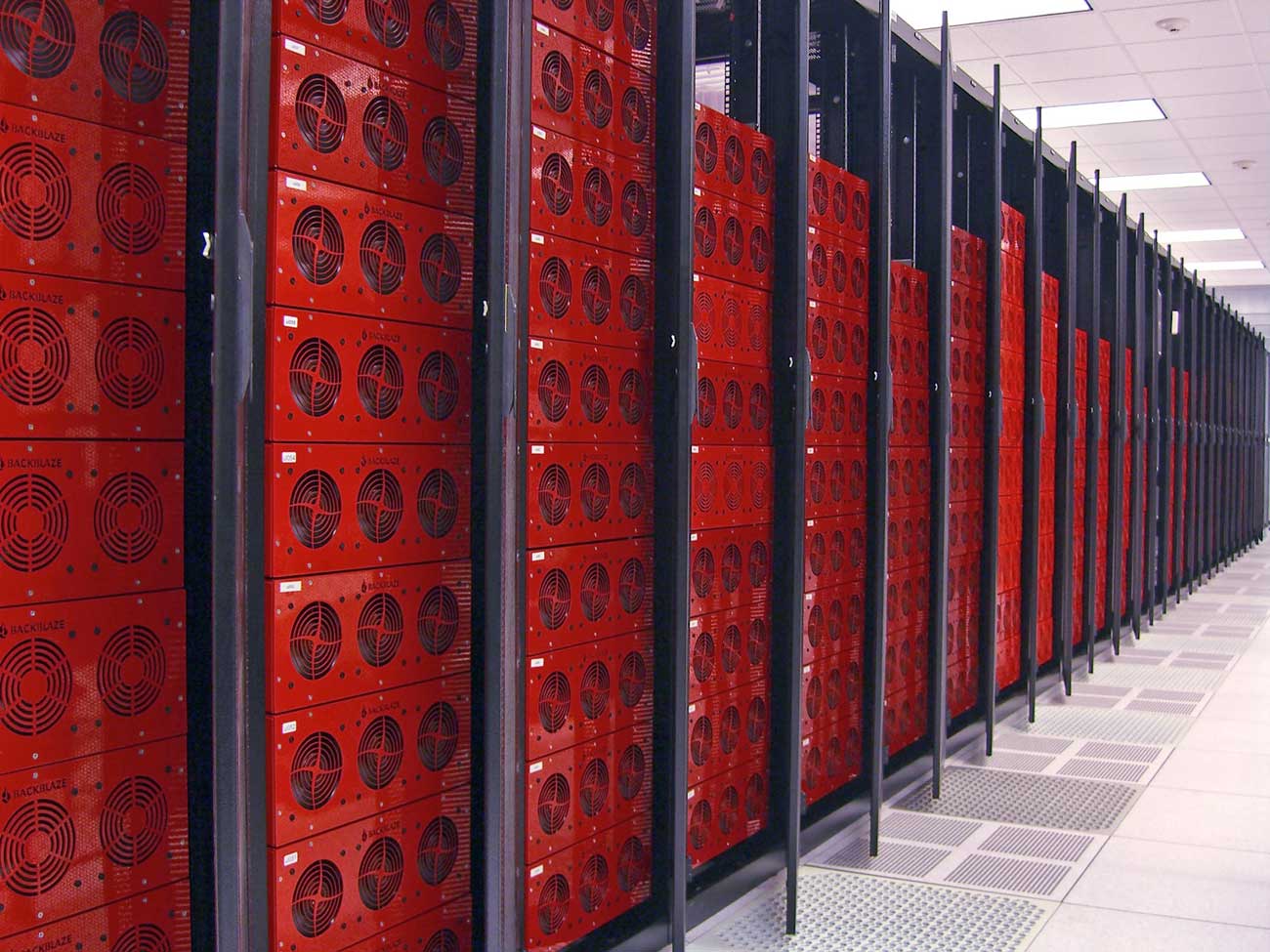
The best cloud backup service
Backblaze
Backing up your files to an off-site cloud server is an easy, affordable, and safe way to make sure that your most important files are safe. For our review, we tested, used, and researched the most popular services, and we recommend Backblaze. It’s the easiest to set up and use. It’s also quite affordable.
To get started, you simply download the Backblaze app from their website, create an account, and then let the app do its thing.
The case for offsite backups
If you boil it down, an off-site “cloud” backup of all the files on your computer is nothing more than insurance. Insurance that if, by chance, your computer and its external backup drive are both destroyed or stolen, you still have an up-to-date copy of your most important files saved somewhere else.
On my computer are:
- Thousands of photographs of our family.
- Hundreds of hours of music (all the CDs that I ripped into iTunes years ago).
- All my tax records for the past several years (with no hard copies in any file systems because I scan-and-shred all my paper).
- Many more vital documents, notes, and passwords that would leave me significantly handicapped were they to be lost due to hard drive failure.
Though it’s unlikely, it’s also possible that my home could be destroyed in a fire or a tornado. It’s also possible that someone could break into my home and steal my computer and its backup hard drive I have on my desk. If that ever happened, replacing the physical items we lost would be the least of my worries. If the aforementioned photographs and documents were lost forever, it would be crushing.
By signing up with a service like Backblaze, you’re taking out an insurance policy on all the most valuable and irreplaceable data on your computer.
When you install Backblaze onto your computer, it runs in the background and you never have to think about it again. It starts by backing up all the documents on your computer. Then, it keeps track of when you create a new file, change a document, or whatever. And when you do, Backblaze uploads the new/modified documents.
This means that a secure and encrypted version of all your files are stored in a data center somewhere far from your house. And thus, in the case that a disaster does happen, the items that would be the most difficult (if not impossible) to replace, are the very items that are now the most secure.
I mean it when I say that having all my files on Backblaze leaves me with peace of mind, because I know that if I wake up at 1:39 in the morning to a smoke alarm, I have nothing to think about other than getting my wife and two sons out of the house safely.
And all for $5/month, give or take a few bucks.
Backblaze review
Backblaze costs $5 per month or $50 per year, per computer.
To get started, you simply download the Backblaze app from their website, create an account, and then let the app do its thing.
Upon initial run, the app will index your computer for all documents, music, movies, photos, and other files. It will then begin backing those files up to the Backblaze data center. Files are, of course, encrypted before being uploaded. More on that in a bit.
Backblaze says it takes the average user about 2 weeks for all their files to be uploaded. On a pretty good internet connection, Backblaze will upload 50+ GB per day. On a slower, DSL connection, it could be as little as 5-10GB per day. I have a Time Warner internet connection with a 5Mbps upload speed, and it took me about 96 hours to upload ~200 GBs of data.
Using Backblaze
One of the main reasons we recommend Backblaze is that you don’t need to fiddle with it at all. Once your initial backup is complete, Backblaze runs in the background and keeps on backing up all new files for you, so long as you’ve got an internet connection, which, by the way, is something cool about using a cloud backup service. You can keep your computer backed up no matter where you are in the world, just so long as you’ve got internet.
However, if you do want to adjust the settings for the Backblaze app, they’re easy.
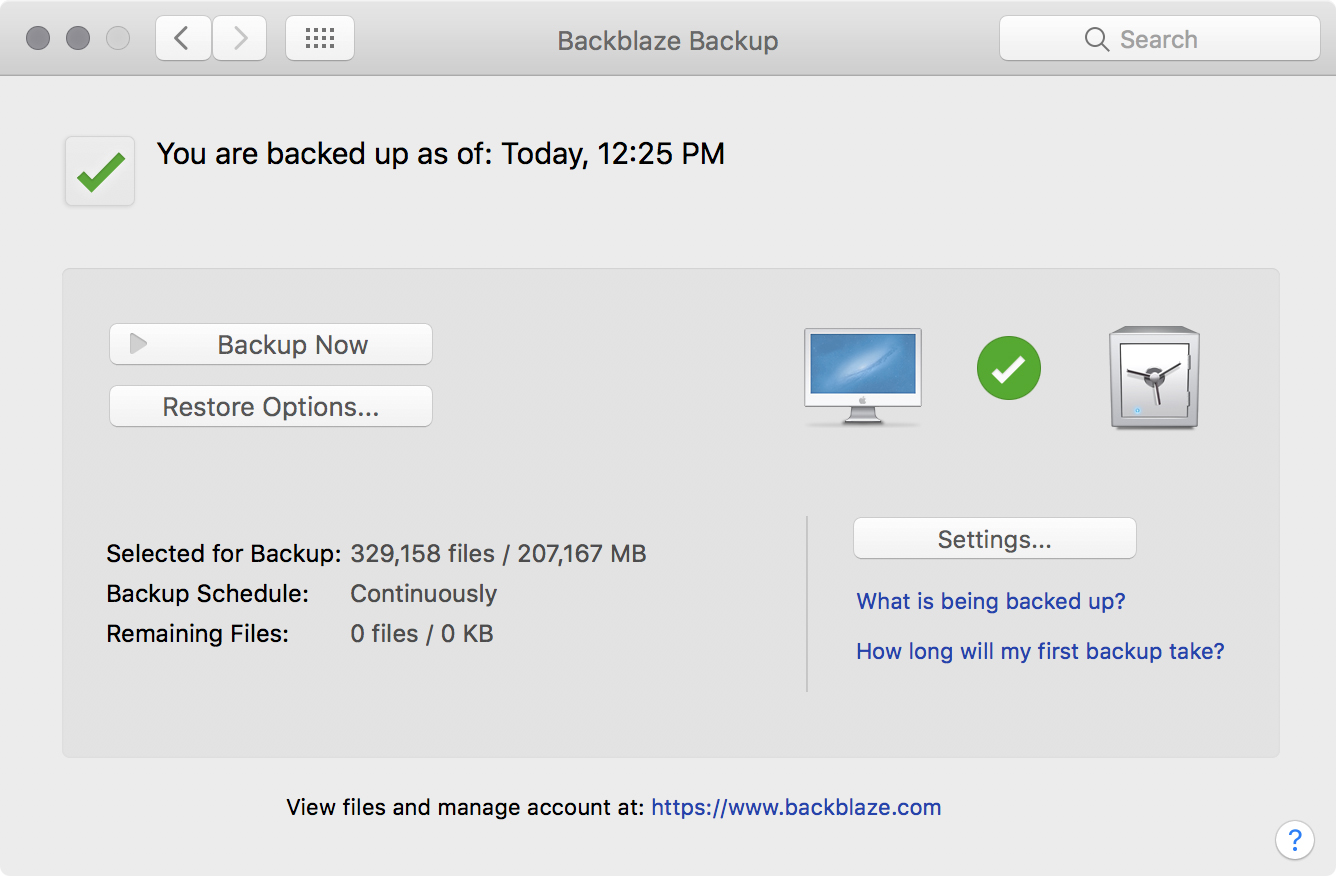
For one, you can choose to set your own limit to throttle the upload speed if you never want it to take up too much bandwidth. Alternatively, you can tell Backblaze to automatically decide how much bandwidth to use, which basically means that when you’re using your computer, Backblaze will slow down its usage of your internet connection, and then when you’re not using your computer, Backblaze will speed back up.
You can also choose to schedule when you want your backups to happen, if not continuously. You can tell Backblaze to only kick in once a day (say in the evenings), or you can tell it not to backup at all unless you specifically click the “Backup Now” button.
I use the default settings and allow Backblaze to back up continuously and automatically throttle its speeds. I used to have it scheduled to only run at nights, but I found sometimes that wasn’t enough for it. Allowing Backblaze to run continuously hasn’t made any noticeable impact on the performance of my computer.
Encryption and security on the Backblaze servers
Before uploading your files to the datacenter, Backblaze encrypts them on your Mac using AES military grade encryption with 128-bit keys. Then, your encrypted files are uploaded over a secure connection to be stored on the Backblaze servers, which are also encrypted. So your files themselves are encrypted and then they are uploaded to discs that are encrypted as well.
Moreover, Backblaze lets you add an additional level of security by creating your own private encryption key. This means that without the private encryption key, nobody, not even Backblaze themselves, can decrypt your files. If you forget what your private encryption key is, your files are unrecoverable. (Side note: An app such as 1Password, that stores passwords, notes, and other things securely, is the perfect place to stash your Backblaze Private Encryption Key.)
On the Backblaze website, they’ve clearly outlined how their encryption and security works in regards to uploading, storing, and recovering your files. In short, the way they handle everything is as secure as it can get (well, it could be more secure if they used 256-bit keys instead of 128). The files that are backed up on Backblaze are more secure than the files you have in Dropbox.
For those who are extremely security suspicious, or who just don’t like the idea of their important files being in the cloud, the Backblaze app allows you to exclude folders from backup. This means you could choose to only use Backblaze for your photos and music if you wish.

Data storage and redundancy in the Backblaze Data Center
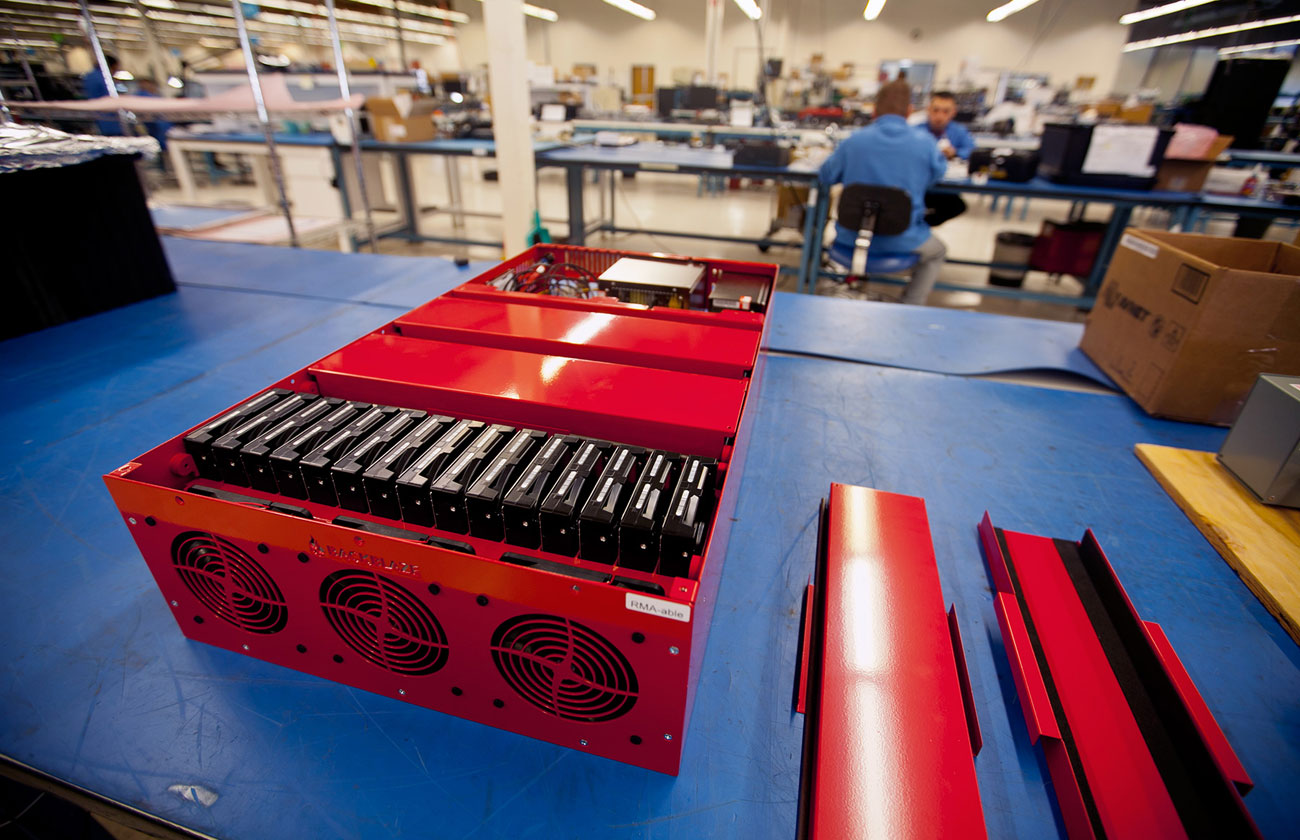
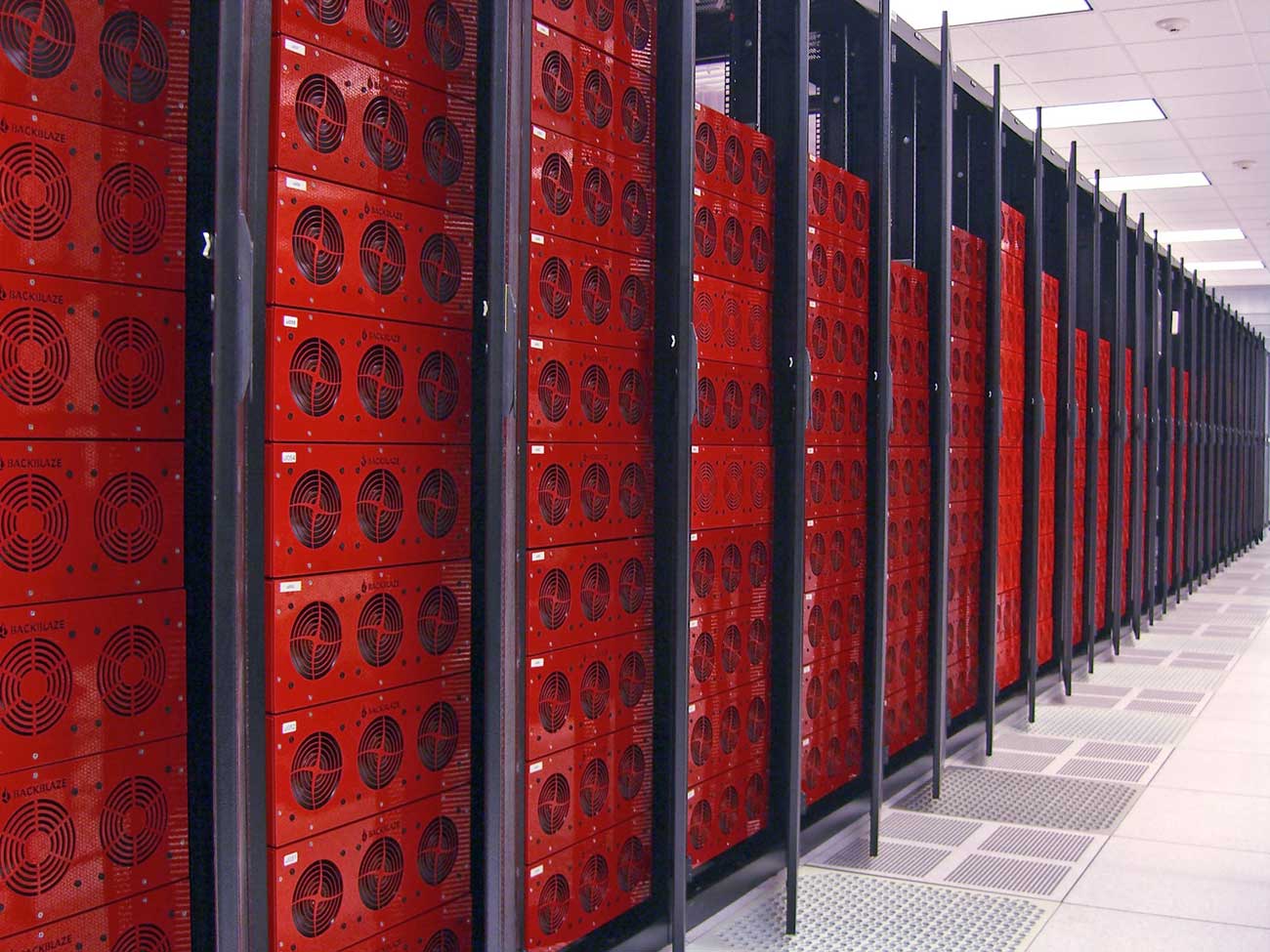
During an AMA (“Ask Me Anything”) thread on Reddit, the Backblaze team answered many questions about their data center, their business model, their encryption standards, and more.
Regarding how their data center stores files, Brian Wilson, Backblaze CTO, said this:
We don’t keep your data on one drive. Your data is stored redundantly across 15 drives in a RAID6 configuration. Thus, if one of our drives in a single 15 drive volume dies, nothing happens. If two drives die, nothing happens. If three drives die, all at the exact same moment, there is some chance we wouldn’t have the data anymore, but you would. So 4 of 16 (15 + yours) would have to die at the exact same moment before any data stands a chance of being lost. We also replace drives before they die based on a bunch of tests that we’re constantly running on the drives to try and predict when one might fail.
For the past 5 years, Backblaze has been chronicling their custom-engineered storage Pods and their evolution of a cheaper, more efficient data center. (You can read more here: Pod 1, Pod 2, Pod 3, and Pod 4.)
Backblaze’s proactive and innovative approach to data storage gives us additional confidence in their service.
For one, it gives us confidence in their business model, that the price they charge of $5/month will be sustainable for them in the long term. Secondly, it gives us confidence in the reliability of their data center to keep our files safe so that if we ever do need to recover our data, it will be ready and waiting for us. If your off-site backup ever becomes your only backup, the last thing you want is to find out it’s been corrupted or lost, or that the single old hard drive it was stored on died.
Recovering your data
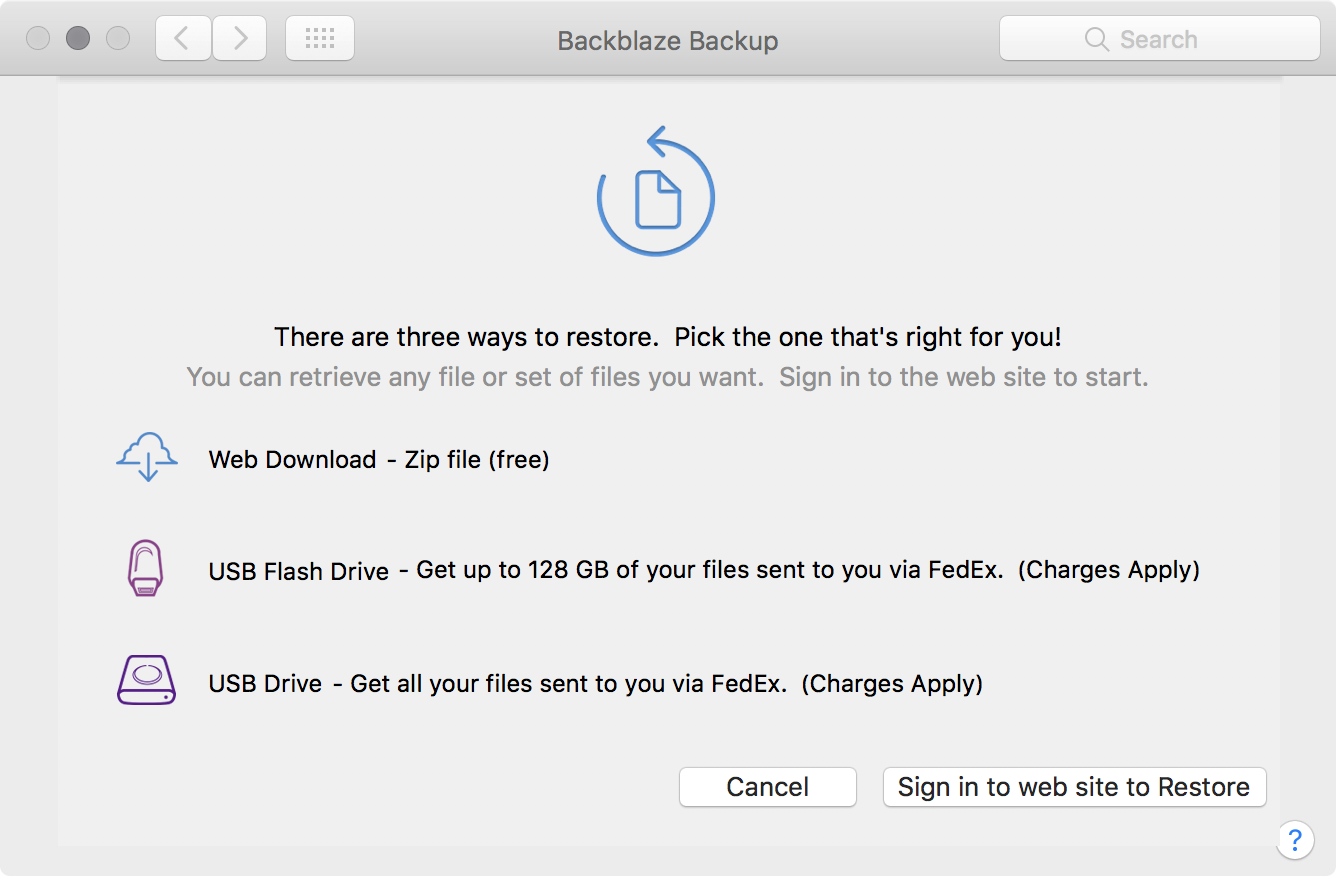
In the event that you need to recover your files from Backblaze, the process is surprisingly simple. You log in to the Backblaze website, click on “View/Restore” files, enter your Private Encryption Key, and then choose what you want to recover.

Backblaze shows you a folder structure that mirrors what you see on your computer. You can navigate through the folders to see all the files that are backed up on Backblaze. You can choose to recover all your files, just some, or even just one single file.
Restoring a file doesn’t “wipe out” your current data set. Backblaze keeps your data until you say otherwise.
To get your files from Backblaze to you, you can choose to have them put the files onto a USB flash drive (up to 128 GB for $99), an external Hard Drive (up to 3 TB for $189), or simply download a ZIP file (no cost to download).
Backblaze has a download helper app you can install for better reliability of large download ZIP files, such as if you’re downloading your entire backup set of hundreds of gigabytes.
Though I have not tried restoring my entire backup set, I have tested various restores of a whole folder and of an individual file. Comparing a set of photos from 2012, I compared the restored copies from Backblaze with the originals that were on my computer, and they were identical. Even comparing differences using Kaleidoscope, I found not a single pixel out of place, and the files were exactly the same size down to the very last byte.
Versioning and deleted file protection
Backblaze keeps a copy of your files for 30 days. If you delete a file on your computer, then in a month it will also be removed from Backblaze’s servers.
During those 30 days, Backblaze also keeps versions of your files. A text document you start on Wednesday, add to on Thursday, edit on Friday, and add to again on Saturday will have four different versions on Backblaze. To navigate to specific versions of a file/folder on the Backblaze site, simply choose the date range for files backed up when you are in the Restore view pictured above.
One of the biggest downsides to Backblaze’s 30-day limit on file protection is that if you leave an external hard drive unplugged from your computer for longer than a month, Backblaze will delete it from their system. They do this as a way to keep their costs down — they’re only keeping a copy of your active data, not all the data you’ve ever had ever. But it means if your main machine is a laptop, and you travel out of town for 31 days and leave your external hard drive at home, all the data on that drive will have to be re-uploaded to Backblaze’s servers when you return from your trip.
On the aforementioned Reddit AMA, the Backblaze team answered a question regarding this 30-day limit. Gleb Budman, CEO of Backblaze, said changing Backblaze’s archiving time to something longer than 30 days may be worthwhile:
I’ve actually been thinking more about this and think that extending it to 60 or 90 could well make sense. We really don’t want people to mistake us for an archiving system or a place to just store data they don’t consider valuable enough to keep themselves. However, 60 or 90 days may be long enough to cover most other scenarios.
However, it was 2 years ago that he said that, and so far the 30-day archiving policy is still in place. So while it may change, it’s not a sure bet.
Backblaze’s iPhone app
The Backblaze iOS app is great for file recovery when you’re out and about. You wouldn’t (nor could you) use the iOS app to restore all your data. But because the Backblaze servers have a copy of your Mac’s files, if you’re away from your computer and need to dig up a document or photograph, then you could get the version that’s on Backblaze.
You log in to the app (it supports TouchID), enter your private encryption key, and then an index of all your backed up files is downloaded to your device. You can then quickly navigate the file structure (which mimics that of your Mac) and get to the file you need. Tapping the file will download it to your iPhone, and once it’s been downloaded, you can then save it to your device, open it in another app, or email it.
Multi-Site HDDs
The idea of keeping a secondary backup hard drive in a Post Office Box or a safety deposit box is clever, but in day-to-day life is no doubt far too much work for most people. It may be safe, but it most certainly is not simple. It means that the longer between visits to the bank or the Post Office, the less up-to-date that off-site backup is. Moreover, PO Boxes and safety deposit boxes are not free. If you’re going to pay to store your data somewhere else, why not pay for a more simple and useful solution that works automatically?
Dropbox
Dropbox may mostly be used for easy sharing and syncing of files, but since the service keeps files on the cloud, it can be used to back up files.
However, this isn’t a great solution if you have a lot of data to deal with. Dropbox’s Pro accounts offer 1 TB of space, but it’s expensive. As the service is designed to sync files, documents or photos accidentally deleted from your local computer will be removed from the cloud as well.
We love Dropbox, but don’t recommend it as a serious cloud backup solution.
Arq
Arq is not an App + Cloud service like Backblaze — it is just an app. You buy it and connect it to your own Amazon S3 account or other cloud service, such as Google Drive, DreamHost, or your own SFTP server.
At first glance, it’s easy to think that putting your data on S3 would be significantly more expensive than the unlimited storage options that Backblaze provides. However, since Backblaze only uploads certain documents, and the general consensus for cloud backups is that you only back up the most irreplaceable files, the cost differences may not be as extreme as you think.
Amazon S3 no longer charges for data uploaded, only data stored. Which means, at today’s current S3 prices, if I were to back up my entire MacBook Air (~200 GB), my monthly Amazon S3 bill would be less than $6/month. If I were to back up all the additional media of movies, photos, and other archived files that are on my external storage drive, it would be a total of ~750 GB and would cost me about $23/month. The most cost effective solution would be to put a select few “critical” files on S3 and everything else (photos and media) on Amazon Glacier — a combination that would run about $7/month.
But here’s where it gets interesting: suppose you don’t have a massive amount of data to back up. Suppose you have 100 GBs or less. In that case, Arq with Amazon S3 is actually cheaper than Backblaze.
So yes, Arq with Amazon S3 can be a tad more expensive for those with a significant amount of data to back up, but you get quite a few advantages. Not the least of which is that Arq keeps the decryption of your data local, whereas Backblaze decrypts on their servers. Another advantage is that, Amazon has several world-class data centers. If you keep your stuff on their Standard Storage they could suffer a simultaneous loss of two whole centers without losing any of your data. On the less-expensive Reduced Redundancy Storage, they could lose one whole data center without losing your data.
The way Arq does backups is similar to the way Time Machine does, meaning it only backs up files that are new or have changed and it keeps past versions of old files as well. You can set a monthly storage budget so that your version storage does not send your S3 costs out of control. When you hit that budget, Arq will delete the oldest versions of files in your S3 account, keeping only the latest copies.
Data recovery from Arq
Restoring from Arq means downloading from your cloud service. You can choose to restore individual files, folders, or download all of it. However, since Arq works similar to Time Machine, you can go back and see versions of your files and restore individual files or folders, so it’s not just for catastrophe recovery.
Arq Summary
The only disadvantage to Arq is the price. Of course, for some people the superiority of Arq’s encryption and Amazon’s reliable data centers may make the price worth it. And for others, depending on the amount of data being backed up, the price may be inconsequential if not equal to or less than the other services.
The advantages to Arq are that it’s a well-built Mac app. It offers very granular control, versioned backups, and it stores your data in Amazon’s reliable data centers or to an SFTP sever of your choosing.
Dolly Drive
Dolly Drive is a Mac-specific cloud backup solution that looks like something Apple itself would design and develop, but the pricing makes it a non-starter for us. Plans start at $10/month for 250 GB, and go up to $100/month for 4 TB of cloud-based storage. Ouch.
Carbonite
Carbonite is another well-known cloud backup service. Offering unlimited space for about $5/month, the price is right. It’s a good alternative to Backblaze, but in our experience, the Mac app has been troublesome, causing hang-ups due to high CPU usage.
Mozy
Mozy has been in the cloud backup game a long time, but the company’s personal offering isn’t all that compelling. $6/month gets you just 50 GB of space, while 125 GB is $10/month. Additional space can be purchased, but at those prices, you’re much better off with Backblaze.
Conclusion
Historically, people have tended to not back up their computers because it seems difficult, expensive, or both. The truth is, however, that keeping duplicate copies of data is easier and cheaper than ever.
As we all store more than ever on our computers, not having the data stored in multiple locations is just plain foolish. 100-percent of computers will fail and all hard drives will die. A good backup solution is easy and automated, and it puts your data on multiple drives in multiple places. Using a cloud backup service answers these needs.
We have a whole section of our site dedicated to doing easy backups of your computer. For more information on backups, check out our main Backups Page.

